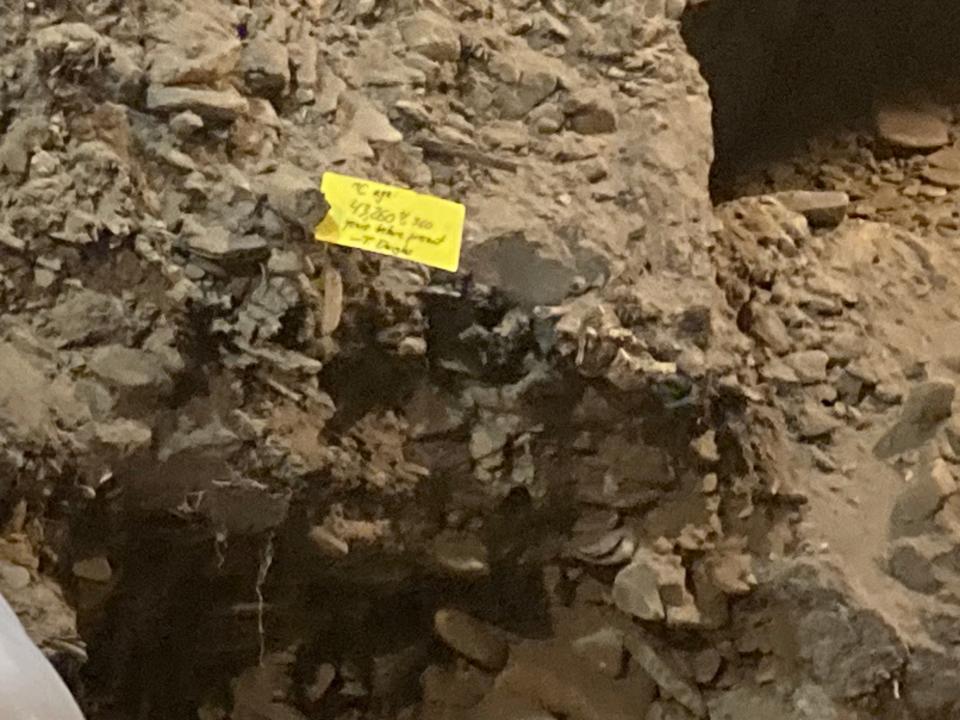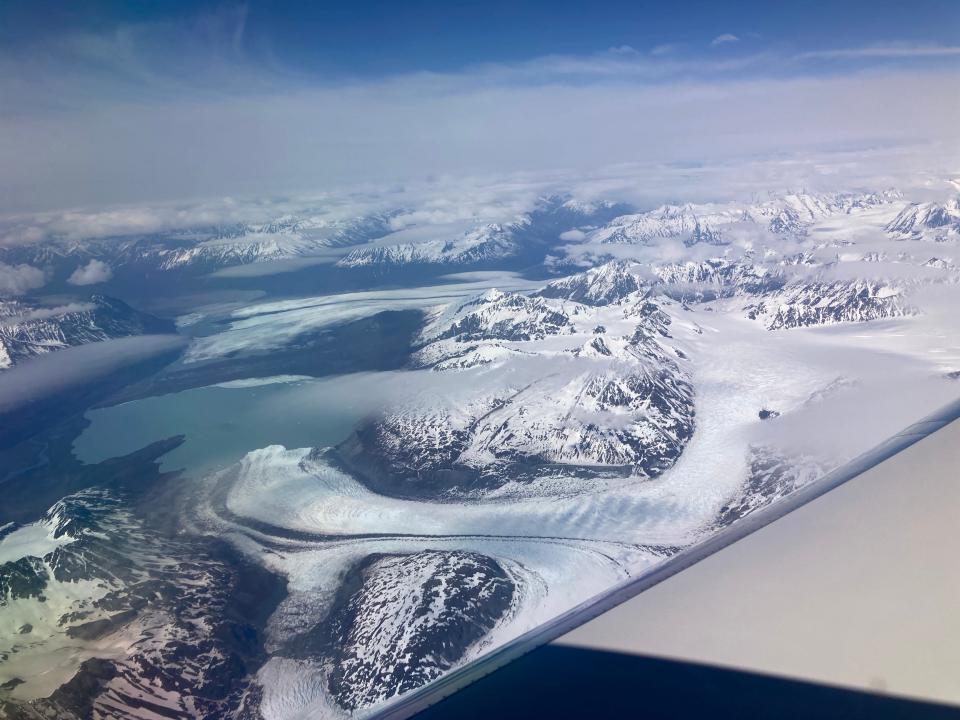Baked Alaska: Climate change's extreme heat is warming the state, and creating national security problems

FAIRBANKS, ALASKA – With extreme heat blanketing the country, chilly Alaska has become baked Alaska – and that is impacting national security.
Temperatures in the Arctic, which encompasses large parts of Alaska, have risen at two to four times the rate of the rest of the world.
Rising seas on Alaska's shoreline have forced the Pentagon to fortify radar sites, covering the kind of sensors that picked up the Chinese spy balloon in January. High temperatures and spikes in summer rains are melting permafrost at places like Eielson Air Force Base near Fairbanks, requiring millions of dollars in fixes for buildings sinking into sodden ground. Summer wildfires burning Canadian forests have closed vital training ranges and warplanes in Alaska.
Sprawling Alaska isn't the buffer that it used to be for Pentagon bases. The spy balloon that penetrated U.S. airspace in January entered the United States over the Aleutian Islands. Spies from China have probed sensitive military sites in Alaska's interior, USA TODAY has reported, and vanishing sea ice has opened shipping lanes to Chinese and Russian military and commercial vessels.
The Pentagon has responded by beefing up its presence in Alaska in recent years: the Air Force bases its most sophisticated fighter jets in the state; the Space Force has a new billion-dollar radar installation, and the Army is adding soldiers to the newly formed 11th Airborne Division to focus on Arctic warfare. The new emphasis comes with a cost: billions in construction to protect against rising seas melting permafrost, according to experts and budget documents.
“There's a significant change afoot in the Arctic region," said Iris Ferguson, deputy assistant secretary of Defense for Arctic and Global Resilience. "First, climate change is very much impacting operations on the ground. There's changing permafrost, there's coastal erosion…It's causing us to rethink how and where we need to operate, and how and where we need to defend our interests."

Why safeguarding the Arctic is vital to national security
The Pentagon's strategy for the Arctic, including Alaska, makes clear the stakes in securing the far north. It's an avenue to attack the U.S. homeland, the Pentagon's inspector general noted in a 2022 report that criticized the Department of Defense for not properly planning for climate change. The report says two main U.S. adversaries, China and Russia, are "operating more freely there," and the region represents a strategic corridor for U.S. troops between the Pacific and Europe. Less sea ice in the summer has also opened new shipping lanes and allowed Chinese fishing trawlers to operate near U.S. shores.
In response, the Pentagon has been beefing up its presence in Alaska. That has meant more troops at its three largest bases – Joint Base Elmendorf-Richardson in Anchorage, and Fort Wainwright and Eielson Air Force Base near Fairbanks. The Air Force has based its top fighter jets, F-22s and F-35s, in Alaska. Near Fairbanks, Fort Greely has sophisticated radars and missiles poised to defend against nuclear missile attacks.
The Pentagon conducts some of its largest-scale training exercises in and around Alaska where it operates training ranges amid seemingly boundless wilderness that dwarf those in the Lower 48 states. On Greenland, the Space Force operates Pituffik, formerly known as Thule Air Base. The Pentagon's northernmost installation has missile defense and space surveillance missions.
"The Arctic has significant homeland defense equities," Ferguson said. "Period."
Related Alaska's army bases see glimmer of hope after 'horrifically high' suicide rates among soldiers

Why it's hard and costly to build in the Arctic
The Japanese occupation of the Aleutian Islands spurred a military-building boom in Alaska in the 1940s. The Cold War sprinkled more radar and other smaller installations across Alaska, Canada and Greenland to detect attacks from Russia.
The end of the Cold War in the 1990s returned Alaska and the Arctic to land largely forgotten by the military. It shows in some of the older barracks at Fort Wainwright where soldiers crowd into rooms and share communal bathrooms.
The increase in Chinese and Russian commercial and military activity has renewed DOD interest in Alaska and the Arctic. U.S. warplanes have regularly intercepted Russian bombers near Alaska since 2007 – which has also renewed DOD interest in the Arctic. Meanwhile, the harsh environment and climate change complicate efforts to bolster the Pentagon's presence here, documents show.
Winter can last nine months and shortens the construction season. Temperatures dropping to 60 below zero and storms with hurricane-force winds batter buildings, weapons and people.
Permafrost, or soil and rock that stays frozen year-round, covers 85% of Alaska. In the very far north, the ground is cold and frozen as deep as 1,000 feet. Farther south, toward Fairbanks, permafrost is thinner, warmer and absent in some places. It's thawing in spots, sometimes under ammunition storage bunkers or runways, requiring costly repairs.
Dig deeper Suspected Chinese spies, disguised as tourists, tried to infiltrate Alaskan military bases
The permafrost in Alaska isn't so permanent anymore
At the Permafrost Tunnel Research Facility north of Fairbanks, Army Corps of Engineers experts study the effects of climate change on permanently frozen ground.
The facility is one of a few in the world and houses some astonishing finds: ice wedges as tall as houses, green grass from thousands of years ago, and bison bones embedded in its permafrost walls. Footsteps kick up fine dust that emits a funky, cheesy odor. A stick, likely 40,000 years old, feels in hand like one you've snapped off a tree in the winter.
"Our permafrost is very rich in organic matter – dead trees shrubs, roots, leaves, grasses, sedges, frozen in the permafrost," said Gary Larsen, operations manager at the Alaska research office. "The Russians refer to this kind of organic-rich permafrost as 'yedoma.' What you are smelling in the permafrost tunnel is the byproduct of microbial activity eating the organic material. Even at temperatures below freezing, microbes eat the organic matter to get at the carbon, and release that smell as well as trace amounts of CO2 and methane."
Permafrost around Fairbanks is warmer than that found above the Arctic Circle and is thawing at a higher rate, Larsen said. Increased summer precipitation, rain, has been seeping into the ground and defrosting it.
"The part of climate change that's actually affecting our environment here quicker than anything else isn't increased temperature," he said. "It's increased rainfall.”
Permafrost rich in gravel doesn't contain as much ice and remains relatively stable as it thaws. Areas with lots of soil and ice can require expensive remediation to support buildings, roads and runways. Crews can scoop out shallow layers of permafrost and build on stable ground beneath. Deeper ice can require buildings to be elevated on piles or kept frozen by mechanical means.
On Greenland, permafrost melt and freezing and thawing have damaged runway shoulders and aircraft hangars, the inspector general found.
What's being fixed, what's being built
The Pentagon has built or plans projects totaling "billions of dollars in infrastructure investment to support increased Arctic operations and space awareness," the inspector general's report noted. One new radar alone at Clear Space Force Station southwest of Fairbanks cost $1.5 billion. The radar is part of a network to "detect threats through effective surveillance of the northern approaches to North America."
Other projects seek to repair damage caused by rising seas or to deal with melting, unstable permafrost:
? Several long-range radar sites in Alaska have required $57 million to bolster a seawall and foundation, study coastal erosion, and repair storm damage.
? A $44 million hangar for F-35 fighter jets at Eielson Air Force Base required $1.6 million to deal with unstable permafrost, including thawing the ground 30 feet beneath the site.
? An addition to a munitions storage bunker at Eielson started as a $2.5 million project. Thawing permafrost beneath the facility compelled the Air Force to cancel the project, bulldoze the bunker and build a new foundation on top of piles that reached solid ground beneath. The project was completed last year for $17.6 million.
The inspector general's report cited another impact of climate change: wildfires. They're expected to burn more intensely and over larger tracts driven by an increase in evaporation and more frequent drought.
In 2019, restrictions due to wildfire risk on a range at Fort Wainwright prevented two squadrons of Air Force fighters from completing bombing practice, according to the report. One squadron missed nearly 40% of its training.
“We're seeing an increased prevalence of fire in general," Ferguson said. "It's not exclusive just to the Arctic."
This article originally appeared on USA TODAY: Baked Alaska: Climate change in the state threatens national security
Solve the daily Crossword

